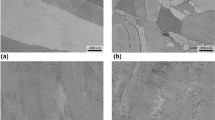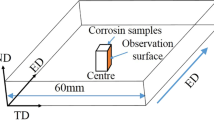Abstract
The volume fractions and morphology of precipitates in precipitation-strengthened Cu-Ti alloys, which precipitate mainly as continuous and discontinuous precipitates, are important for the application of the alloy. This study employed hardness and electrical conductivity tests, transmission electron microscopy (TEM), atom probe tomography (APT), and first-principles calculations to demonstrate that the addition of Mg is effective for accelerating nanosized continuous β′-Cu4Ti precipitation as well as for suppressing the precipitation of coarse lamellar discontinuous β-Cu4Ti precipitates along the grain boundaries, resulting in Cu-Ti alloys with high yield strength and good electrical conductivity. The results showed that the continuous precipitation of β′-Cu4Ti was accelerated by the Mg additions, which reduced the supersaturation of the matrix, thereby reducing the chemical driving force for the discontinuous precipitates. On the other hand, Mg additions increased the mismatch between the discontinuous β-Cu4Ti precipitates and matrix, decreased the nucleation rate of the discontinuous precipitates, and increased the spacing of the discontinuous precipitation layer, resulting in a lower growth rate of the discontinuous precipitates. Therefore, the addition of Mg to Cu-Ti alloys enhances the strength and improves the resistance to over-ageing.
Graphical abstract

摘要
析出强化型Cu-Ti合金中析出相的体积分数和形貌对合金的性能影响巨大, 其主要强化相为连续析出相(CP)和不连续析出相(DP)。本研究通过透射电子显微镜、原子探针断层扫描和第一性原理计算证明添加Mg元素能够加速纳米尺寸连续析出相β′-Cu4Ti相的析出以及抑制片层状不连续析出相β-Cu4Ti相的形核与长大, 从而制备得到了具有高屈服强度和良好导电性的Cu-Ti合金。一方面, Mg元素的添加加速了连续相β′-Cu4Ti相的析出, 降低了基体的过饱和度, 从而降低了不连续相沉淀的化学驱动力。另一方面, Mg元素的添加增大了β-Cu4Ti相与基体的错配度, 降低了不连续相的形核速率, 同时使不连续相的片层间距增大, 导致不连续相的生长速率也降低。因此, 向Cu-Ti合金中添加Mg元素提高了合金的强度并改善了其抵抗过时效的性能。









Similar content being viewed by others
References
Laughlin DE, Cahn JW. Spinodal decomposition in age hardening copper-titanium alloys. Acta Metal. 1975;23(3):329. https://doi.org/10.1016/0001-6160(75)90125-X.
Cornie JA, Datta A, Soffa WA. An electron microscopy study of precipitation in Cu-Ti sideband alloys. Metall Mater Trans B. 1973;4(3):727. https://doi.org/10.1007/BF02643081.
Sinning HR, Haasen P. The fatigue behaviour of spinodally decomposed Cu-4at% Ti single crystals. Scr Metall. 1981;15(1):85. https://doi.org/10.1016/0036-9748(81)90142-3.
Soffa WA, Laughlin DE. High-strength age hardening copper–titanium alloys: redivivus. Prog in Mater Sci. 2004;49(3–4):347. https://doi.org/10.1016/S0079-6425(03)00029-X.
Ecob RC, Bee JV, Ralph B. The structure of the β-phase in dilute copper-titanium alloys. Phys Status Solidi. 1979;52(1):201. https://doi.org/10.1002/pssa.2210520121.
Wang X, Xiao Z, Qiu WT, Li Z, Liu F. The evolution of microstructure and properties of a Cu–Ti–Cr–Mg–Si alloy with high strength during the multi-stage thermomechanical treatment. Mater Sci Eng A. 2021;03:140510. https://doi.org/10.1016/j.msea.2020.140510.
Nagarjuna S, Sharma KK, Sudhakar I, Sarma DS. Age hardening studies in a Cu–4.5Ti–0.5Co alloy. Mater Sci Eng A. 2001;313(1–2):251. https://doi.org/10.1016/S0921-5093(00)01834-7.
Datta A, Soffa WA. The structure and properties of age hardened Cu-Ti alloys. Acta Metall. 1976;24(11):987. https://doi.org/10.1016/0001-6160(76)90129-2.
Liu WJ, Li J, Chen X, Ji MH, Xiao XP, Wang H, Yang B. Effect of vanadium on the microstructure and kinetics of discontinuous precipitation in Cu–3.2Ti–0.2Fe alloy. J Mater Res Technol. 2021;14:121. https://doi.org/10.1016/j.jmrt.2021.06.045.
Saito K, Suzuki M, Hayasaka Y, Takenaka K, Semboshi S. Effect of magnesium doping on discontinuous precipitation in age-hardenable copper–titanium alloys. Mater Charact. 2022;189:111911. https://doi.org/10.1016/j.matchar.2022.111911.
Semboshi S, Takasugi T. Fabrication of high-strength and high-conductivity Cu–Ti alloy wire by aging in a hydrogen atmosphere. J Alloys Compd. 2013;580:S397. https://doi.org/10.1016/j.jallcom.2013.03.216.
Semboshi S, Konno TJ. Effect of aging in hydrogen atmosphere on electrical conductivity of Cu–3 at.% Ti alloy. J Mater Res. 2008;23(2):473. https://doi.org/10.1557/JMR.2008.0050.
Semboshi S, Kaneno Y, Takasugi T, Masahasi N. Suppression of discontinuous precipitation in Cu-Ti alloys by aging in a hydrogen atmosphere. Metall Mater Trans A. 2020;51(7):3704. https://doi.org/10.1007/s11661-020-05801-5.
Fukamachi K. Kinetics and thermodynamics associated with age hardening of Cu–4at%Ti alloy. Mater Sci Eng A. 2020;788:139411. https://doi.org/10.1016/j.msea.2020.139411.
Rouxel B, Cayron C, Bornand J, Sanders P, E.Loge R. Micro-addition of Fe in highly alloyed Cu-Ti alloys to improve both formability and strength. Mater Des. 2022;213:110340. https://doi.org/10.1016/j.matdes.2021.110340.
Saito K, Suzuki M, Semboshi S, Sato K, Hayasaka Y. Isothermal aging behaviors of copper–titanium–magnesium supersaturated solid-solution alloys. Mater Trans. 2020;61:1912. https://doi.org/10.2320/matertrans.MT-M2020149.
Li S, Li Z, Xiao Z, Li SH, Shen LN, Dong QY. Microstructure and property of Cu–2.7Ti–0.15Mg–0.1Ce–0.1Zr alloy treated with a combined aging process. Mater Sci Eng A. 2016;650:345. https://doi.org/10.1016/j.msea.2015.10.062.
Le SC, Huang J, Guo CJ, Zhang WH, Hu YB, Hu CH. The effect of Ag addition on the microstructures and properties of Cu-15Ni-8Sn alloy. Copper Eng. 2022;2:13.
Li C, Wang XH, Li B, Shi J, Liu YF, Xiao P. Effect of cold rolling and aging treatment on the microstructure and properties of Cu–3Ti–2Mg alloy. J Alloy Compd. 2020;818:152915. https://doi.org/10.1016/j.jallcom.2019.152915.
Liu J, Wang X, Ran QN, Liu YF, Li C. Pre-deformation and Aging Characteristics of Cu-3Ti-2Mg Alloy. Rare Met Mater Eng. 2018;47(7):1980. https://doi.org/10.1016/S1875-5372(18)30168-1.
Huang L, Cui ZS, Meng XP, Zhang XW, Zhang XY, Song XP, Tang N, Xiao Z, Lei Q, Li Z. Effects of microelements on the microstructure evolution and properties of ultrahigh strength Cu–Ti alloys. Mater Sci Eng A. 2021;823:141581. https://doi.org/10.1016/j.msea.2021.141581.
Huang L, Peng LJ, Mi XJ, Zhao G, Huang GJ, Xie HF, Zhang WJ. Relationship between microstructure and properties of high-strength Cu-Ti-Cr alloys during aging. J Alloy Compd. 2023;942:168865. https://doi.org/10.1016/j.jallcom.2023.168865.
Zhang JL, Jiang YS, Zheng WS, Liu YS, Addad A, Ji G, Song CJ, Zhai QJ. Revisiting the formation mechanism of intragranular κ-carbide in austenite of a Fe-Mn-Al-Cr-C low-density steel. Scr Mater. 2021;199:113836. https://doi.org/10.1016/j.scriptamat.2021.113836.
Guo W, Chen Y, Hong ZY, Song HW, Wang KL, Zhang SH, Qiu Q. Effect of electromagnetic stirring frequency on microstructure and properties of Cu-2Ag-00.4La alloy. Copp Eng. 2022;1:10.
Li ZM, Körmann F, Grabowski B, Neugebauer J, Raabe D. Ab initio assisted design of quinary dual-phase high-entropy alloys with transformation-induced plasticity. Acta Mater. 2017;136:262. https://doi.org/10.1016/j.actamat.2017.07.023.
Zhou BC, Yang T, Zhou G, Wang H, Luan JH, Jiao ZB. Mechanisms for suppressing discontinuous precipitation and improving mechanical properties of NiAl-strengthened steels through nanoscale Cu partitioning. Acta Mater. 2021;205: 116561. https://doi.org/10.1016/j.actamat.2020.116561.
Liu DM, Yin CS, Hua YH, Zhang DL, Li YA, Ma BJ, Zhao XC, Xie HF, Peng LJ, Huang GJ, Mi XJ. Microstructure and physical properties of Cu-2.3Ni-0.5Si alloy with thermo-mechanical treatment. Rare Met. 2023;42(1):64. https://doi.org/10.1007/s12598-022-02109-8.
Leonard WF, Lin SF. The validity of Matthiessen’s rule for metallic films. Thin Solid Films. 1975;28:9. https://doi.org/10.1016/0040-6090(75)90285-0.
Duly D, Brechet Y. Nucleation mechanism of discontinuous precipitation in Mn-Al alloys and relation with the morphology. Acta Metall. 1994;9:3035. https://doi.org/10.1016/0956-7151(94)90400-6.
Guo C, Shi YF, Chen JS, Xiao XP, Liu BX, Liu JP, Yang B. Effects of P addition on spinodal decomposition and discontinuous precipitation in Cu-15Ni-8Sn alloy. Mater Charact. 2021;171: 110760. https://doi.org/10.1016/j.matchar.2020.110760.
Acknowledgements
This work was financially supported by the Technological Innovation 2025 & Major Special Project of Ningbo (Nos. 2021Z084 and 2020Z039).
Author information
Authors and Affiliations
Corresponding authors
Ethics declarations
Conflict of interests
The authors declare that they have no conflicts of interest.
Rights and permissions
Springer Nature or its licensor (e.g. a society or other partner) holds exclusive rights to this article under a publishing agreement with the author(s) or other rightsholder(s); author self-archiving of the accepted manuscript version of this article is solely governed by the terms of such publishing agreement and applicable law.
About this article
Cite this article
Huang, L., Peng, LJ., Li, J. et al. Properties and microstructure of copper–titanium alloys with magnesium additions. Rare Met. 43, 2290–2299 (2024). https://doi.org/10.1007/s12598-023-02544-1
Received:
Revised:
Accepted:
Published:
Issue Date:
DOI: https://doi.org/10.1007/s12598-023-02544-1




